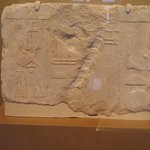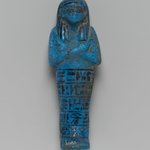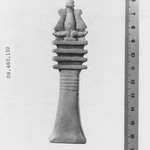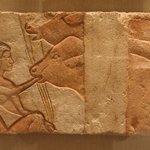Osiris
Egyptian, Classical, Ancient Near Eastern Art
Votive animal mummies were associated with the king of the realm of the dead, Osiris, while his son, the hawk-headed Horus, was his successor on earth.
Osiris became the prototype for proper death because he was the first to be mummified and achieved eternal life in the next world. Thus all mummies of humans and animals imitated the mummification process and form followed to reanimate Osiris in the next world.
MEDIUM
Wood, gesso, paste, bronze, electrum, gold leaf
DATES
4th century B.C.E. or later
DYNASTY
Dynasty 30, or later
PERIOD
Late Period to Ptolemaic Period
DIMENSIONS
7 5/16 x 3 3/8 x 1 5/16 in. (18.6 x 8.6 x 3.4 cm)
(show scale)
ACCESSION NUMBER
37.1374E
CREDIT LINE
Charles Edwin Wilbour Fund
CATALOGUE DESCRIPTION
Small gilded wooden figure of Osiris, god of the dead. Osiris is depicted as a mummy, wearing the white crown with a copper alloy uraeus on top, with attachments for feathers, now missing. He holds a metal flail in one hand and presumably held a crook in the other hand, now missing. The flail is possibly made of electrum, based on its muted golden color and that it has not corroded. A remnant of what may be the crook is hidden in the hole in Osiris’s right hand. His eyes are inlaid with painted irises and part of an inlaid chin strap remains on his left side, as well as a hole at the chin where a beard would have been attached.
The figure is made of wood which has been covered in a plain weave textile, a layer of gesso, and then gilded over the entire surface. Incisions in the gesso create a decorative collar around the front and down the back of the neck. At the bottom of the figure is a tenon, also wood, for attachment to a base.
Condition: The object is in fair overall condition. There are many losses to the gilding and gesso, but the edges of the losses appear to be stable. In some places the gilding is abraded to reveal the surface of the gesso, but in others the gesso is completely lost to reveal the textile underneath or even the wood below. The gilding is abraded with dents and gouges over the entire surface, with a slightly better appearance on the back of the object, but it is not actively flaking. There is discoloration over the figure’s face which appears to be from excess resin (original?) or dirt trapped in previous treatment material around the features, especially the nose and eyes There is a large crack around the foot area which has been repaired, but the repair appears to be relatively stable. There are small cracks throughout the gilded surface
MUSEUM LOCATION
This item is not on view
CAPTION
Osiris, 4th century B.C.E. or later. Wood, gesso, paste, bronze, electrum, gold leaf, 7 5/16 x 3 3/8 x 1 5/16 in. (18.6 x 8.6 x 3.4 cm). Brooklyn Museum, Charles Edwin Wilbour Fund, 37.1374E. Creative Commons-BY (Photo: Brooklyn Museum (Gavin Ashworth,er), 37.1374E_Gavin_Ashworth_photograph.jpg)
IMAGE
overall, 37.1374E_Gavin_Ashworth_photograph.jpg. Brooklyn Museum photograph (Gavin Ashworth, photographer), 2012
"CUR" at the beginning of an image file name means that the image was created by a curatorial staff member. These study images may be digital point-and-shoot photographs, when we don\'t yet have high-quality studio photography, or they may be scans of older negatives, slides, or photographic prints, providing historical documentation of the object.
RIGHTS STATEMENT
Creative Commons-BY
You may download and use Brooklyn Museum images of this three-dimensional work in accordance with a
Creative Commons license. Fair use, as understood under the United States Copyright Act, may also apply.
Please include caption information from this page and credit the Brooklyn Museum. If you need a high resolution file, please fill out our online
application form (charges apply).
For further information about copyright, we recommend resources at the
United States Library of Congress,
Cornell University,
Copyright and Cultural Institutions: Guidelines for U.S. Libraries, Archives, and Museums, and
Copyright Watch.
For more information about the Museum's rights project, including how rights types are assigned, please see our
blog posts on copyright.
If you have any information regarding this work and rights to it, please contact
copyright@brooklynmuseum.org.
RECORD COMPLETENESS
Not every record you will find here is complete. More information is available for some works than for others, and some entries have been updated more recently. Records are frequently reviewed and revised, and
we welcome any additional information you might have.














































